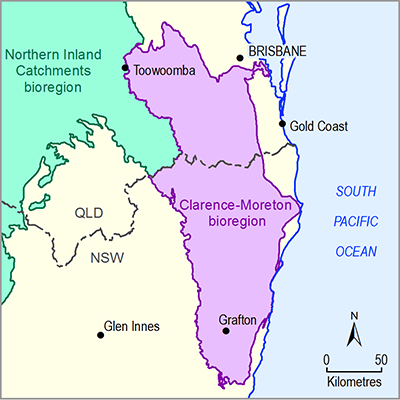- Home
- Assessments
- Bioregional Assessment Program
- Clarence-Moreton bioregion
- 1.5 Current water accounts and water quality for the Clarence-Moreton bioregion
Executive summary

Information on surface water and groundwater quantity and quality for the Clarence-Moreton bioregion is documented in this product. The information was captured in October 2015 and is used in the evaluation of the potential impact of coal seam gas and coal mining development on water and water-dependent assets.
Water accounts
The Richmond river basin includes the Richmond and Wilsons rivers plus the Toonumbar Dam and Rocky Lake reservoirs which have a combined storage of 25 gigalitres. A few small dams and weirs supply water to agricultural, domestic and municipal users. In the Richmond river basin, permits to extract surface water amount to 99.8 gigalitres per year.
The Richmond River alluvium and Lamington Volcanics are the two main groundwater supply aquifers in this bioregion.
The National Groundwater Information System describes 3934 bores within the Clarence-Moreton bioregion. Actual usage data from these bores does not exist, therefore usage has been estimated using allocation information from the New South Wales state groundwater database. It is presumed that 100% of the water allocation is used, which is likely to be an overestimate.
Estimates indicate that just over 88% of bores have allocations of less than or equal to 5 megalitres per year. Around 50% of estimated groundwater use is for irrigation, and 42% is for stock and domestic use.
Water quality
The largest collection of water quality data for the Richmond river basin is maintained by the New South Wales Government. These data include continuously collected water quality parameters and information from targeted sampling campaigns.
Continuous surface water quality measurements are not widely available for gauging locations in the Richmond river basin and many measurements only commenced in 2013.
Targeted sampling campaigns by the New South Wales Government have collected information on electrical conductivity, pH and turbidity over many years with most parameters falling within acceptable levels.
Groundwater quality data are available from the New South Wales Office of Water for more than 500 bores within the Richmond river basin for between 1971 and 2007.

